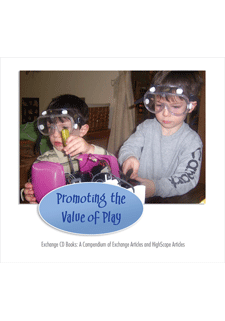ExchangeEveryDay Past Issues
 << Previous Issue
| View Past Issues | | Next Issue >>
<< Previous Issue
| View Past Issues | | Next Issue >> -Dan Roam, The Back of the Napkin
"The importance of playing in appropriate environments is ever more significant in a society where children are pressured by expectations into assuming the roles of adults at an increasingly young age. We can see this happening when children prefer clothes and electronic objects to simple and collective toys and games. ... Nowadays children generally play less than in the past; they don't play as many street games, and they are no longer capable of producing their own toys.
"We also see this phenomenon in the increasing amount of restrictions to children’s playing environments, and the lack of spaces where children can be without having to share the space with an infinity of other things.
"For these reasons it is important to develop activities and spaces that promote spontaneous fun and games, offering the natural joy of freedom, involving children and helping them to grow. However, it is also necessary for playing to contain innovative elements, based on listening to the needs and expectations of the children."

That's right, Exchange's Value of Play CD Book includes over 100 articles from Exchange and the HighScope Foundation. And the updated version includes the latest "Infant Toddler Toy Guide" by Teachers Resisting Unhealthy Children's Entertainment (TRUCE). Issues addressed by the 100+ articles include...
- The Purpose of Play
- HighScope Perspectives on Play
- Advocating for the Value of Play
- Play in Practice
- Taking Play Outdoors
- Play Materials
ExchangeEveryDay
Delivered five days a week containing news, success stories, solutions, trend reports, and much more.
What is ExchangeEveryDay?
ExchangeEveryDay is the official electronic newsletter for Exchange Press. It is delivered five days a week containing news stories, success stories, solutions, trend reports, and much more.
The early childhood administrator's yellow brick road leads to a FREE social media webinar on October 6! Child Care Administration 2.0. conducted by the technology Wizard, Chip Donohue, Ph.D. Register now!


Comments (3)
Displaying All 3 CommentsShishu Vikash Kendra
Kolkata, West Bengal, India
Thank you Madam geeta bhatt for memorising the mother land India . Really, when the children play in open air without bondage they are madly free.
the grand child care center
chicago, IL, United States
It is true that in a low income neighborhood creating a healthy environment for children to play and flourish is very difficult .But with visionary creative mind social workers we CAN make a difference.
A few years ago , visiting My motherland India during Monsoon season I was surprised to see children playing in rain and making paper boats and letting them 'sail' through the 'stream' while singing some nursery rhyme. The K.G. teacher told me,' this is the perfect opportunity for these children to be connected to the nature.' 'What about their wet clothes?' I asked.
'They will dry in a while' She answered without hesitation.
Geeta Bhatt, Director,
Grand Child Care Center, Chicago.
Sunshine Corners
Strasburg, PA, United States
I take issue with the quote, "they are no longer capable of producing their own toys." If children are given the time, raw materials and space for thinking they can use their imaginations and dream up any number of creative, play-type activities including making their own toys.
Post a Comment